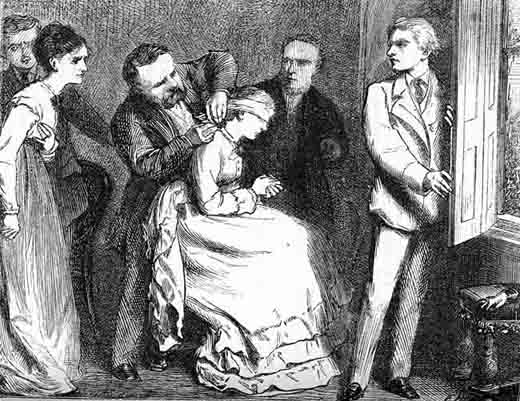Dear Serial Readers,
I found this image (see sidebar) of Crosbie at Courcy Castle, a Millais illustration that appeared in The Cornhill with this installment. I can't say I see much of the struggling that Trollope's narrator suggests for this character around his conflict over the entitled or encastled life versus small houseness via marrying Lily. While I accept the narrator's assertion that Crosbie "was not altogether a villain," Crosbie's ability to compartmentalize in contrast to Lily's lingering gaze and thoughts might reveal their materially-gendered circumstances. For what is it about Crosbie's social status (he's a London clerk, right?) that allows him to hob-nob with the likes of the De Courcys and Dumbellos, whereas Lily is confined to occasional visits to the Great House up the road? It also seems a cheap shot to suggest that the countess's "craft" is ultimately the culprit for Crosbie's likely jilting of Lily for the wealthier Alexandrina. But clearly in Trollope's universe, material conditions exert a huge pressure on marriage plots.
I was amused this time by the allusion to Wilkie Collins's best-selling The Woman in White (1860) as Lady Dumbello enters the drawing room at Courcy Castle. Like Anne Catherick, Lady Dumbello is haunted by her modest antecedents as the daughter of a country parson. This wink to a very popular novel first serialized in All the Year Round reminds me of Julia's remark about serial installments forestalling "last moments."
In contrast to Maura's satisfaction with the previous month's (or week's, in our case) set of chapters, I found this one irksome and dull, largely because it focused entirely on Crosbie. The "elevated" De Courcys and their friends are introduced, but with so little warmth and humor that I found the lot rather tedious, especially Alexandrina and her conniving mother. And I confess I just wasn't engaged by Crosbie's straining conscience about Lily. I hope Maura is right with her hunch that his duplicity (that letter with its subtle loophole!) will lead to more interesting turns in Lily's character.
Next week, chapters 19-21. I hope to find more variety of scenes and characters, and especially more Lily and more Johnny Eames.
Serially speculating, as always,
Susan

2 comments:
Well I get to write on the last 6 chapters since I didn't post last time, which is nice, since as Susan aptly notes, a section entirely focused on Crosbie is a little disappointing. I did like the brief reference to Lily's morning as a contrast to Crosbie's in chapter 18. I do see Crosbie falling, falling out of our favor, but I also believe Trollope could bring him back into the light just as Eames has risen in most of our opinion. I don't feel I can tell yet whether Crosbie will ultimately see the old Clergyman, Lady Dumbello's grandfather, as a symbol of the horrors of giving up society for humbler surroundings or as a symbol of the sadness of the complete separation of the two worlds.
So, I haven't given up on Crosbie yet, but certainly at this point I hope Lily finds consolation with someone else quickly and I wouldn't mind if that someone were Eames. And I resent Crosbie's affections to Alexandrina, but I also understand the desire to be friends with the popular and rich group. I can have a bit of sympathy for him, but not enough to forgive him without some real change!
I was intrigued by the Earl's kindness to Eames and, apparently, to Eames's mother, and in my usual way I wondered if he is really Eames's father, but the Earl's fond memories of Eames's father suggest not.
When I see we are barely 1/4 of the way through the novel, I think that many more complications can arise. I wonder if original serial readers knew how many more installments there would be, so could gage how close we are to the end. When I watch a tv show, I partly know whether there is another twist coming by how many minutes are left before the end. So, did serial readers know when the last day would come?
I am glad to have another day, and I'm especially excited to read about the Squire's visit to the Little House. (and, a by the way, I wonder if the lengthy discussion of the fact that the Great House is not actually entailed yet the squires always act as if it were, from way back in the first chapter, is to prepare the reader for shock when some changes happen to the property lines of Allington.)
A quick response to your question, Kari, on reader expectations about serial lengths. Twenty installments was fairly standard, both for Dickens and,at least in this case, for Trollope. And I think it was common to announce the start of a serial by advertising the number of installments--"BLEAK HOUSE in twenty numbers!" So, yes, I imagine readers would've had a sense of where in the larger arc of the novel an episode fell. This one is about a third of the way.
Post a Comment